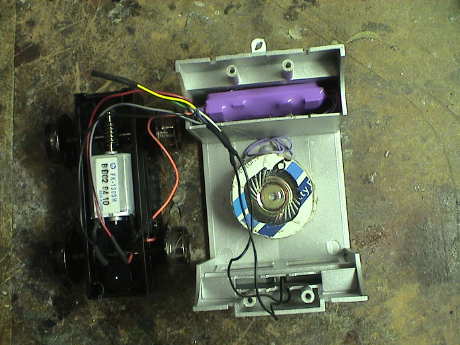 31 May 10
31 May 10 20 Aug 09
20 Aug 09 18 Aug 09
18 Aug 09 5 Dec 09
5 Dec 09[ Home ] [ Up ] [ Previous Page ] [ Next Page ]
 31 May 10
31 May 10 20 Aug 09
20 Aug 09 18 Aug 09
18 Aug 09 5 Dec 09
5 Dec 09For literally years, Soundtraxx has claimed that they were going to make a combined sound/DCC decoder for large scale. That hasn't happened yet. They did make a follow on to their DSD family of sound/DCC decoders. This new family is called the Tsunami. It is available in HO and N sizes. The TSU-1000 is a 1 amp stall current unit that can handle most HO sized locos. The smaller, and more expensive, TSU-750 is good for 0.75 amps and will fit and run in many N scale locos.
If Soundtraxx ever decides to release their claimed 4 or 8 amp version of the Tsunami, they may give QSI and the other sound decoder manufacturers a run for their money.
The quality of the decoders are quite good with nearly as much programmability as a QSI decoder and excellent sound quality. They will both drive standard 8 ohm speakers and make enough audio power to be useful for large scale but the motor drivers are very limiting. The Tsunami, by spec, won't handle a Bachmann Railtruck or Davenport. It will barely handle a USAT Speeder.
The Tsunami doesn't coordinate it's sound and motion as nearly as well as a LokSound decoder, has a lower motor current rating, it's bigger and it costs a little more. It has a little more in the way of automatic sound controls, will apply more modifications to the basic sound and has a stronger audio amp that will drive an 8Ω speaker, but overall, I think that the LokSound decoder is a better deal.
The Soundtraxx Tsunami is also somewhat limited by track voltage. It is rated at 22 volts and it will run there or higher but it doesn't much like it. Better to run it closer to 18 volts as described on my USAT Speeder tips page.
Soundtraxx has published manuals on their web site that describe the programming of these decoders in detail. I haven't yet worked through them but when I find issues, I'll point them out here.
One issue that I came across almost immediately is that these decoders don't accept page mode programming on a standard Digitrax programming track. To use page mode, a "programming track booster" such as a SPROG II is needed to boost the signal to the programming track. However, the decoder will accept OPS mode programming on the main without difficulty and I was able to change sound parameters and define a 4 digit DCC address in OPS mode.
I was able to use a SPROG and JMRI to read back and save the entire contents of the decoder. I could also use the SPROG as a command station to actually drive the decoder. However, the Tsunami resolutely resisted service mode (Pg, Pd or Ph) programming on a programming track driven by a Digitrax DCS100 command station. Even a PR3 used as a standalone programmer could not program the Tsunami.
The decoder has many programming options. There is a master volume control, as well as sub controls for each sound effect. There is also an equalizer to allow the frequency response of the unit to be tailored to a specific speaker. This can be done via some general offsets for generic speakers or via a 7 band adjustable equalizer.
There are several selectable horns. These vary from program to program. There are 16 slots for different horns, but all of them are not populated in the Galloping Goose sound program. The horn can be set to play automatically on start and stop like the old Sierra. However, unlike the Sierra, when the horn is set to automatic, it can also be manually played. If your throttle supports a playable horn/whistle, the Tsunami can be programmed to change it's volume and reverb when manually played.
The bell is also programmable for ring rate and volume. It can also be set to ring automatically at low speed, although it seems to do it only when starting out and not when slowing down. The automatic bell set points can be adjusted to specific throttle levels.
Special effects, such as reverb, can be added in different amounts to several different sounds. Sounds can also be played when the decoder is analog converted so that it will actually add sound to a loco run on a DC layout was well.
The manual describes a brake squeal function that I didn't initially hear. The issue is that the mixer level for the squeal was too low, it was there, it just didn't poke it's head above the other sounds. I reset the level for the brake squeal to max and it showed up. The squeal is triggered either by F11 or by a rapid decrease in speed. The number of speed ticks necessary to trigger the squeal is also programmable.
The motor control functions are about the same as other BEMF decoders. I didn't have to diddle them for acceptable BEMF performance.
The decoder supports all the standard DCC stuff, Vmin, Vmax, acceleration, deceleration, speed tables and function remapping. Each function output can be assigned one of several common special effects.
I finally got a Soundtraxx Tsunami TSU-1000 Sound and Motor DCC decoder. I had one on order for nearly a year to go into the Bachmann Railtruck, but finally, Soundtraxx said that they weren't going to make one with a Goose sound file. I gave up, cancelled the order and bought an ESU LokSound v3.5decoder instead.
Then they apparently had a change of heart and did eventually make the Tsunami with a Goose sound file. I bought one for use in a USAT Speeder.
 The TSU-1000
sound decoder isn't very suitable for large scale because it is
rated for 1 amp stall current, a spec that few large scale locos
can meet. However, the Speeder draws only 700 mA at full stall so
the Tsunami could handle it. It also just barely fit.
The TSU-1000
sound decoder isn't very suitable for large scale because it is
rated for 1 amp stall current, a spec that few large scale locos
can meet. However, the Speeder draws only 700 mA at full stall so
the Tsunami could handle it. It also just barely fit.
The TSU-1000 is considerably longer and thicker than a Digitrax DH163 or DH123. I have used several of these in HO installations and in some cases, I had trouble finding room for them. The Tsunami may be a challenge for some HO installations.
The wiring was very simple, all the wire colors matched DCC standards except for the two purple speaker wires. The Tsunami uses an 8 ohm speaker and makes pretty good volume as compared to other HO sized decoders. I originally tested it with a much better speaker in a better enclosure and it did well. This speaker cannot reproduce the bass but it does well enough.
Not shown in this picture, there is also an external capacitor attached to the decoder. It may be a DC storage capacitor to allow it to ride over dirty track. It also may be a DC blocking capacitor for the speaker. However, since the decoder appears to shut down virtually instantly at a track power interruption, it seems more likely that the external capacitor is a speaker DC block. The decoder doesn't do quite as well as the ESU LokSound decoder on dirty track, but it does well enough. It does much better than the older Soundtraxx DSX sound only decoder, both in terms of sound volume and the ability to handle dirty track.
The TSU-750 is a smaller, but more expensive, version of the TSU-1000 intended for N scale or tighter HO installations. I will probably never get one, but it appears to be the same unit just packaged a little tighter and with lower ratings.
Since all the TSU-750 and TSU-1000 decoders, steam or diesel, use the same basic firmware with just different sound programs, they all work pretty much the same. I have a Galloping Goose (diesel) version so I cannot evaluate steam related features such as the use of a chuff cam instead of speed sensing via the DCC commands.
My Tsunami is installed in a USAT Speeder, a very stressing case for power pickup. The Speeder's power pickup is good in comparison to many small locos but there still are only 4 wheels on a rigid frame. The Tsunami therefore sees many small power interruptions and deals with them fairly gracefully. If the interruption occurs when the speed is set to zero, the Tsunami interprets that as a power up event and it goes through an engine start sequence. If the speed is non-zero, the Tsunami does the best it can when power is interrupted and immediately returns to playing the engine sound at whatever speed it hears in the first DCC packet it receives on power up.
The sound quality is quite good but, like other high end sound systems, it is highly sensitive to the quality of the speaker. In the Speeder, my speaker isn't real great, but there is no place to install much of a better one. I could get a "high bass" small speaker for it and it may help marginally with the low end but for now, I have set the equalizer preset CV153=6 because this sounded best to my ear for my particular speaker.
The sound and speed do not coordinate as well as the ESU LokSound decoder. The Tsunami should be able to do a better job because it's BEMF system knows the motor speed. The Tsunami allows you to stop the motor and it leaves the sound still running. I needed to set CV3 and CV4 to about 10 to get better, but still not perfect, coordination between sound and speed. Even then, I cannot slam the throttle to zero from some low speed to get the brake squeal effect to play without the Speeder stopping faster than the engine sound does. More diddling with the programming may help that.

The picture above is a link to a QuickTime movie of the Tsunami in action.
The Tsunami decoder has a capability for "playable" horns with DCC command stations and throttles that support this feature. The Digitrax DT-400 throttle does have a playable horn in the form of a pressure sensitive F2 button. This capability has to be enabled on the throttle by setting the throttle OPSW#3 to x80 more than the value that is in that OPSW already.
The Tsunami also has a CV that determines if it will respond to a playable throttle at. That is CV47 and to make it work with a Digitrax command station, the value in CV47 must be 127. This value will be different for other systems but I have not clue as to what it might be.
Overall, the result of enabling the "playable" horn in the Goose sound file was less than impressive as demonstrated in the movie below.

If that movie format doesn't work, try this one.
[ Home ] [ Up ] [ Previous Page ] [ Next Page ]
This page has been accessed times since 17 Aug 09.
© 2009-2010 George Schreyer
Created 17 Aug 09
Last Updated May 31, 2010